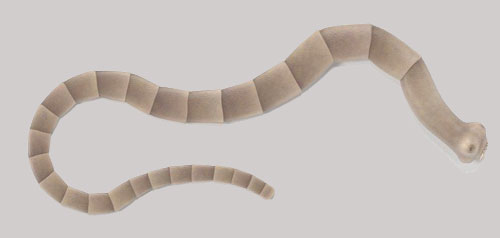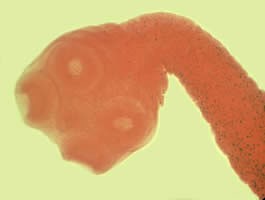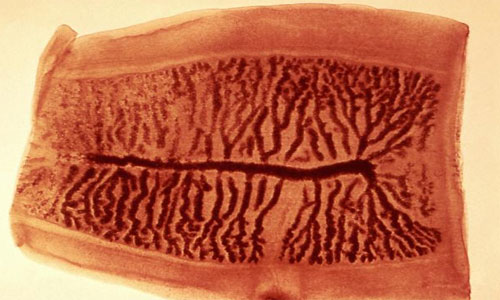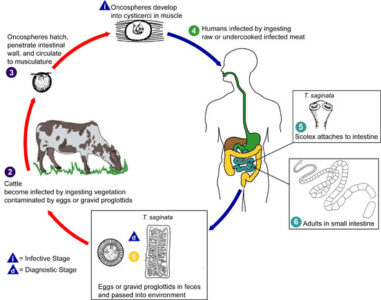Taenia saginata is also known as the beef tapeworm. It is found amongst beef eaters all over the world. The adult worm lives in the small intestine (upper jejunum) of human. This is the unarmed tapeworm of man causing taeniasis and it can cause cysticercosis in cattle.
The cattle acts as intermediate host and in this case, larval development occurs while human acts as definitive host which harbor the adult worms.
Geographically, they are available in South Asia, Southeast Asia, Africa, Europe and Latin America.
Human lives are infected if they take raw or undercooked beef. Because, under cooked beef contains infective larvae, known as cysticerci.
Human releases embryonated eggs or oncospheres through faeces which are transmitted to cattle during taking contaminated fodder. In muscle, lungs, liver of cattle, eggs or oncospheres are developed into ineffective cystiverci.
- Definitive Host: Human, Adult worm.
- Intermediate Host: Cattle, Cysticercus larvae
Systematic Position
- Phylum: Platyhelminthes
- Class:Cestoda
- Order: Cyclophyllidea
- Family: Taeniidae
- Genus: Taenia
- Species: Taenia saginata
Morphology of the Adult Worm
It is white, semitransparent and it measures 5 to 24 meters in length. Scolex (head) measures 1 t0 2 mm, quadrate in shape, has four circular suckers but has no rostellum or hooked. Neck is narrow and long proglottids (segments) are from 1000 to 2000.

The length of the gravid segment is 3 to 4 times its breadth. The common genital pore is marginal and alternates irregularly between the right and left margins. The gravid uterus has a central longitudinal stem with 15 to 30 lateral branches on each side. There is no uterine pore.

Scolex of T. saginata : Image credit-wikimedia commons
A gravid segment passes out of the anal orifice, ruptures and lays eggs in the perianal skin. It may live up to 10 years.

Gravid proglottid of T. saginata : Image credit-Wikimedia commons
Life Cycle of Taenia Saginata
The worm passes its life cycle in two hosts: (i) Definitive host-Human harbors the adult worm and (ii) intermediate host- cow or buffalo harbors the larval stage.
The adult worm lives in the small intestine (upper jejunum) of human. Eggs and gravid segments are passed out with faeces on the ground. The gravid proglottides expel the eggs on rupture after it passes outside.
The eggs are swallowed by cattle while grazing in the field. In the intestine of the intermediate host (cow or buffalo), the eggs rupture and oncospheres (hexacanth embryos) are liberated. These penetrate the gut wall with the aid of their hooks and gain entrance into the circulation.

Image showing life cycle of T. saginata: Image credit-wikipedia
They finally reach muscles where they develop into the larval form cycticircus bovis in 8 to 10 weeks. Muscles commonly infected are the tongue, neck, shoulder, ham and cardiac muscle.
Human becomes infected by eating undercooked meat containing living larvae. In the intestine of man, the scolex anchors to the wall by means of its suckers and develops into an adult worm.
The worm is sexually mature in 2 to 3 months and starts producing eggs which pass in the faeces. Thus, the cycle is repeated.
Pathogenesis and Clinical Features
Infection occurs by ingestion of undercooked infected meat of the intermediate host. Majority of Taenia saginata infections are asymptomic. Common symptoms are:
- Epigastric pain;
- Nausea;
- Vomiting;
- Change in appetite;
- Weight loss;
Spontaneous emerging of motile proglottid may cause perianal discomfort. Intestinal obstruction is a rare complication.
Diagnosis
To diagnose, stools are examined. In this case, microscopic examination is needed to find parasite eggs. Naked eye examination is made for segments. It is examined for scolex after anthelmentic. It is not possible to identify up to species level by examining the egg. The scolex or the gravid proglottids help to identify as Taenia saginata.
Treatment
Taeniasis can be treated using praziquantel. In this case, you should use 5-10 mg/kg for single administration. Niclosamkide is also used to treat the taeniasis. For adult and children over 6 years, 2 gm is used as single dose after a light breakfast. Albendazole is highly effective against cattle infection.
Prevention
Beef should be cooked under 560 C temperature to destry the cysticerci. If you keep the beef in refrigeration, the freezing temperature should be below -100C for 9 days or more to destroy the cysticerci. Besides these, human excreta should be made disposal properly to avoid cattle infection.
